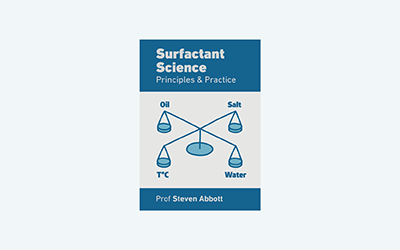Foamability
Quick Start
For decades there has been confusion about what makes a surfactant solution "foamable". This app shows both that "it depends" and what it depends on. This is an early version and should evolve as we gain access to more of the key parameters described below.
Credits
As in so much of Practical Surfactants, this app is based on awesome work from the Denkov lab in Sofia1.
Foamability
Warning: include(apps/js/foamability.v1.js): Failed to open stream: No such file or directory in /var/www/vhosts/stevenabbott.co.uk/httpdocs/practical-surfactants/Foamability.php on line 31
Warning: include(): Failed opening 'apps/js/foamability.v1.js' for inclusion (include_path='.:/opt/plesk/php/8.3/share/pear') in /var/www/vhosts/stevenabbott.co.uk/httpdocs/practical-surfactants/Foamability.php on line 31
Three foaming curves
If you plot relative foam amount versus concentration of surfactant you will get 3 curves depending on your foaming technique. The default values (0.01, 0.3, 4) are for Tween 20. Why three values, and why should we care? Read on to find out.
Three sources of confusion
Foamability has been the source of much confusion and uncertainty. Thanks to the work described here, it's clear that we get confused by three, somewhat interrelated effects:
- Inherent speed: When we try to judge how foamable a surfactant is, we tend to use "our" definition of the process by which we're judging it. The problem is that foamability depends strongly on the method used. A "slow" technique such as the Foam Rise Method (FRM) (as used in a Dynamic Foam Analyzer) is completely useless for "real" foams where the more relevant Ross-Miles and Kenwood mixer techiques are middle speed and the Barsch test is high speed.
- Surfactant type: Different surfactant types tend to have different speeds of getting to the air interface, and different rigidities once they get there. The concentration above which a surfactant can give a good foam (C50 described below) varies according to the foaming speed. So a brilliant low CMC non-ionic FRM surfactant might be useless for more dynamic techniques. As shown in DST Choice a high CMC system might be much faster because surfactant molecules aren't too tied up in micelles.
- Interfacial rigidity: A rigid interface can make foams "stronger" against the challenges of foaming, so that's good, but can also make the foam more viscous which, in some methods, makes it harder to mix in more air. It therefore looks "poorly foamable" in terms of trapped air volume. In terms of foam quality,the bubble size gets smaller, making the foam even more rigid, but superbly long-lasting.
Those 3 factors have added great confusion to what makes a surfactant foamable. The review by Tcholakova & Petkova1 clears up this confusion and allows us to have a handy app to guide us through foamability space.
The key is a universal formula that describes the foamability of all the surfactants they have looked at. If the volume of air V compared to the maximum foamability Vmax is determined across a range of concentrations, C, and if without surfactant you get a volume V0 of foam, then, knowing two parameters b=0.13 and d=0.44, plus V0 typically 10%,then you just need the key value C50 and you have:
`V/V_max=V_0/V_max+(1-V_0/V_max)/(1+exp(-(log(C/C_50)-b)/d))`
If we make the reasonable assumption that Vmax is the same for all relevant surfactants, then what distinguishes different surfactants are the C50 values, defined as the concentration where you can achieve half Vmax. This value is the source of the confusion behind foamability.
C50 is both surfactant and speed-dependent
With a slow surfactant such as a long-chain non-ionic, C50 can be wonderfully low, so you get full foaming at a low concentration in a FRM experiment. Yet that same surfactant requires a much higher concentration in a Kenwood or Barsch experiment. The opposite applies. For multiple reasons, anionics can perform poorly at low concentrations (low foam production and instability at the surface) in the FRM but give stellar foaming in a fast method.
As a community, "all" we need are C50 values for each surfactant and each technique. Unfortunately, the Sofia work is too recent for us to have a large set of values. Maybe someone with an advanced robotic setup can obtain a large set of values to give to the community.
But to get you started, here are 3 sets of values from the paper:
- Tween 20: FRM=0.01, Kenwood 0.3, Bartsch 4
- Brij 58: FRM=0.01, Kenwood 0.3, Bartsch ~8
- SDS: FRM=0.3, Kenwood 1, 3
1Slavka Tcholakova and Borislava Petkova, Bubble size and foamability: Role of surfactants and hydrodynamic conditions, Current Opinion in Colloid & Interface Science 2024, 72:101824


